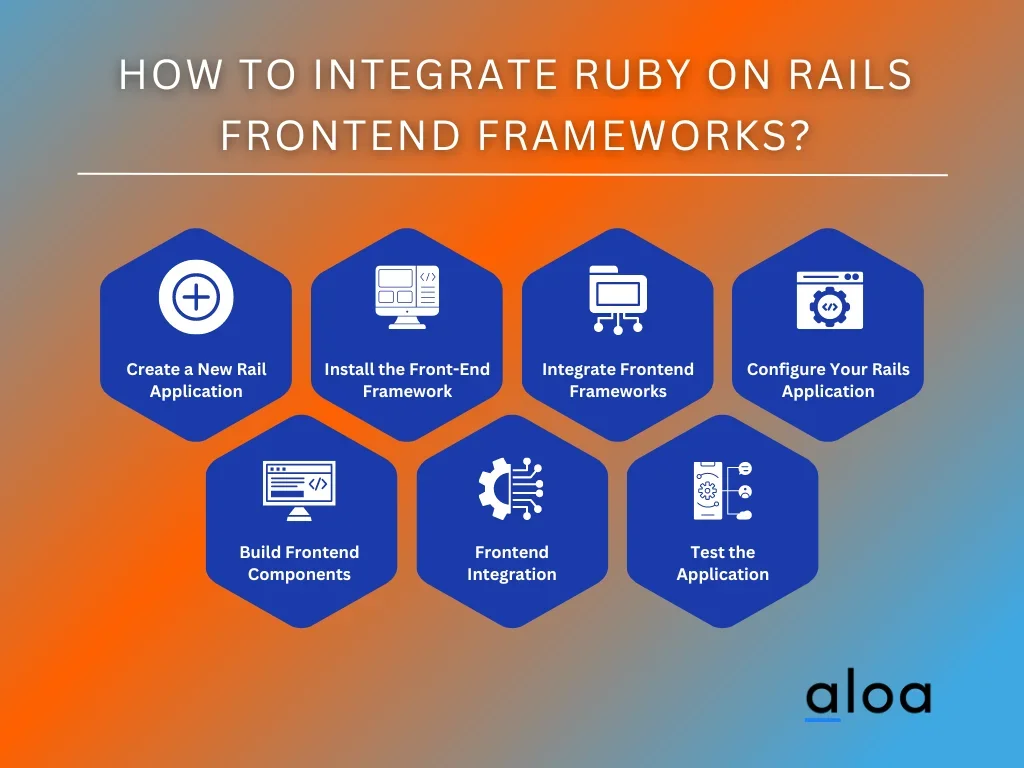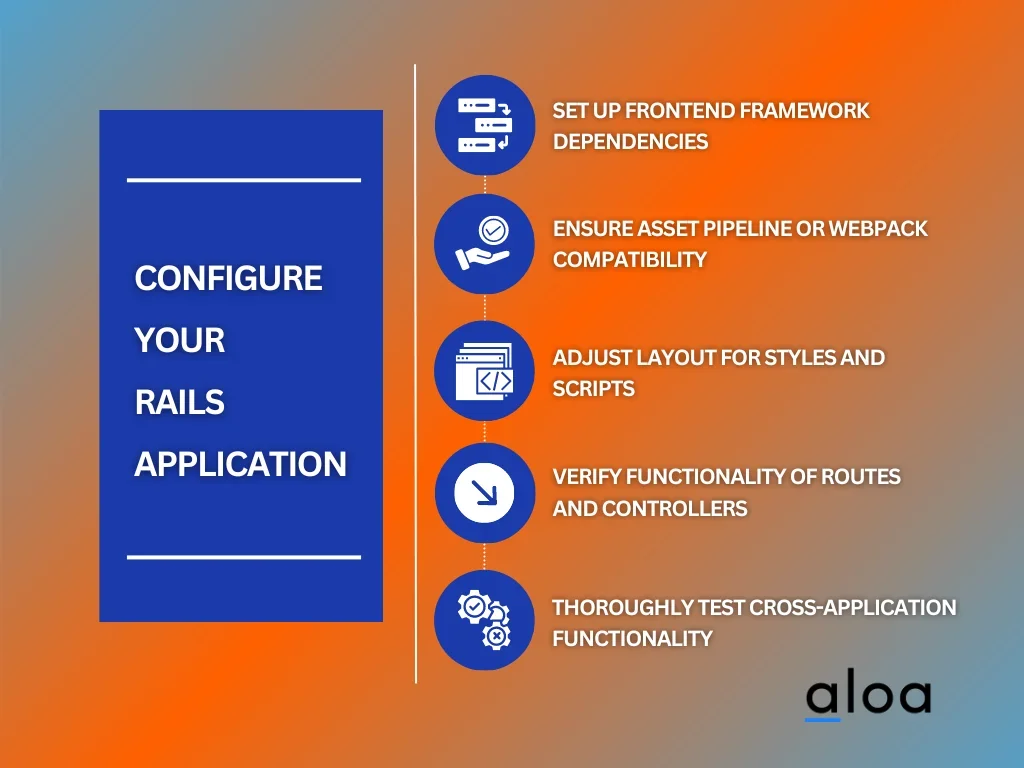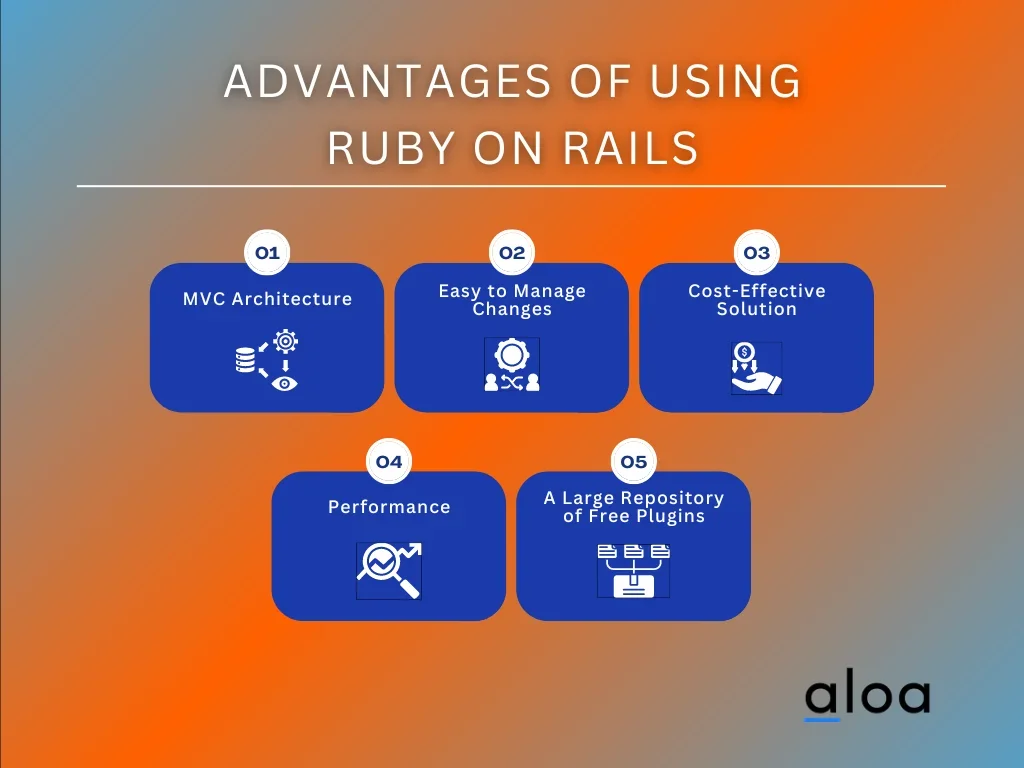With the advent of web development in 2024, developers have constantly sought ways to streamline web application building. One such development framework that has gained popularity among programmers is Ruby on Rails. Made with easy-to-use facility and simplicity, Ruby on Rails frontend gives developers the toolkit power to build web applications successfully.
Aloa, a software outsourcing expert, helps and connects businesses to scale their web and app development teams. Whether you are looking to staff multiple web developers or build out a specific product, Aloa ensures that you are working with the best web development talent worldwide. Our rigorous vetting process ensures businesses and startups interview top-tier candidates who are adept at software development.
Leveraging our expertise in using various frameworks like Ruby on Rails, we’ll go over this blog to provide an overview of Ruby on Rails frontend and how it can be used in frontend development. With that, we aim to provide developers with expert insights on how to seamlessly integrate such a framework to create scalable web applications.
Let's dive in!
What Is Ruby on Rails?
Ruby on Rails, often called Rails, is an HTTP application framework programmed in Ruby. Its architecture is based on Model-View-Controller (MVC), based on the principle of “less is more,” meaning developers can be free from coding whole applications. This approach enhances efficiency, as developers can avoid repetitive tasks and create robust, scalable web applications with a more streamlined coding process.
What distinguishes Ruby on Rails as a platform is the basis on which it was solely designed—to make the lives of developers more accessible and to increase their productivity. Besides, the framework is supported by an ecological system of "gems," which are ready-to-use modules and plugins, essentially speeding up development by making earlier tasks available as pre-built solutions.
With its simplicity and efficiency, Ruby on Rails remains popular among freelance software developers as it facilitates rapid app development without sacrificing code quality.
What is Frontend Development?
Front-end development involves creating a website's visual and interactive elements while shaping the user interface and experience. It encompasses design implementation, utilizing layout, colors, typography, and interactive features to enhance user engagement. Front-end developers are crucial in translating designers' creative vision into a seamless and visually appealing digital experience.
The fundamental technologies in front-end development include HTML, CSS, and JavaScript, each serving a distinct purpose. HTML structures the content, CSS styles, and formats it, while JavaScript adds dynamic and interactive elements, creating a collaborative dance between these essential languages.
This synergy makes web pages look visually pleasing and function seamlessly across various devices, highlighting the critical role of technical expertise in front-end development.
How To Integrate Ruby on Rails Frontend Frameworks?
Integrating Ruby on Rails frontend frameworks combines backend and frontend technologies, creating dynamic web applications with advanced features. This offers benefits such as optimal frontend framework selection and enhanced use of frontend components. Let's explore these steps to understand how developers can integrate frontend frameworks with Ruby on Rails.

Step 1: Create a New Rail Application
Embarking on a new Ruby on Rails frontend project involves a series of crucial steps to ensure a seamless integration of a front-end framework. To start your project successfully, you must create a new rail application. Here's a breakdown of the critical steps:
- Initiate Your Project: Utilize the "rails new" command, specifying your app's name.
- Select a Frontend Framework: Choose a framework such as Bootstrap or Tailwind CSS based on your project requirements.
- Install the Chosen Framework: Add the chosen framework to your Gemfile and execute `bundle install` to install the required dependencies.
- Customize Your Rails Layout: Tailor your Rails layout to incorporate the chosen frontend framework's features seamlessly.
- Leverage Framework Resources: Make the most of the framework's resources and documentation for optimal results in your Ruby on Rails frontend development.
Following these structured steps ensures a smooth integration process, setting the stage for a well-designed and functional frontend application using Ruby on Rails.
Step 2: Install the Front-End Framework
Enhancing the user interface of a Ruby on Rails frontend application involves a critical step: installing a front-end framework. Here are some considerations when doing this step:
- Consider Compatibility and Ease of Integration: Consider factors like compatibility, ease of integration, and community support when selecting a framework.
- Utilize Popular Frameworks: Popular frameworks like Bootstrap and Tailwind CSS provide pre-built components, expediting development.
- Follow Installation Instructions: It is essential to prevent internal errors and follow the specific installation instructions provided by the chosen framework.
- Streamline Design Process: Integration of a Ruby on Rails frontend framework can streamline the design process, resulting in an elevated overall user experience.
Step 3:. Add Frontend Frameworks to Your Application
Enhance your application's user interface and responsiveness by integrating frontend frameworks and utilizing the Rails assets pipeline. Follow these steps for a polished and user-friendly design:
- Integrate Framework: Achieve design consistency and responsiveness by integrating Bootstrap or Tailwind CSS.
- Utilize Asset Pipeline: Seamlessly include CSS and JavaScript files into your application through the Rails assets pipeline.
- Optimize Component and Utility: Improve UI elements and interactivity by maximizing the framework's components and utilities.
- Assure Compatibility: Ensure compatibility with Rails by adhering to best practices and providing comprehensive documentation.
Step 4: Configure Your Rails Application
Configuring a Ruby on Rails frontend application involves several steps to ensure a smooth integration of front-end components. Below is a breakdown of the process.

- Set up Frontend Framework Dependencies: Integrate the necessary dependencies for the chosen framework to enhance the application's functionality.
- Ensure Asset Pipeline or Webpack Compatibility: Guarantee compatibility with the asset pipeline or Webpack configuration to optimize the management of frontend assets.
- Adjust Layout for Styles and Scripts: Customize the layout to incorporate styles and scripts, providing a visually appealing and responsive user interface.
- Verify Functionality of Routes and Controllers: Validate the seamless interaction of routes and controllers with the newly integrated frontend components.
- Thoroughly Test Cross-Application Functionality: Conduct comprehensive testing to ensure the proper functioning of the integrated frontend components across the entire application.
Step 5: Build Frontend Components
Developers craft reusable elements to enhance the user interface when creating Ruby on Rails frontend components. From buttons to interactive widgets, this approach ensures a streamlined development process, maintaining design and functionality consistency. Here is a simple breakdown of this step:
- Define Reusable Elements: Developers start by defining reusable elements such as buttons and interactive widgets for the user interface.
- Leverage Frameworks: Utilize frameworks like Bootstrap or Tailwind CSS to streamline the development of front-end components.
- Ensure Consistency: Implement frameworks to ensure consistent design and functionality throughout the application.
- Facilitate Future Updates: Establish a consistent code base to easily facilitate the implementation of future updates, ensuring scalability and adaptability.
Step 6: Integrate the Frontend Components
After building frontend components, optimize your Ruby on Rails integration and focus on seamlessly integrating frontend components. Below are the specifics for this step.
- Integrate with Rails Assets Pipeline: Integrate frontend components seamlessly through the robust Rails assets pipeline.
- Check Compatibility: Ensure compatibility between Rails conventions and the specific needs of your chosen frontend framework.
- Integrate using 'Webpacker' Gems: Explore using gems like 'webpacker' for a streamlined and efficient integration process.
- Provide Thorough Testing: Prioritize comprehensive testing to guarantee a flawless user experience with your front-end components.
- Leverage NLP Terms: Enhance your content by strategically incorporating NLP terms, such as Ruby developers, web developers, code base, software development, and restful routing.
Step 7: Test the Application
Ensuring a smooth integration of the Ruby on Rails frontend framework requires meticulous testing. Testing frameworks such as RSpec or Capybara are crucial in automating these processes by identifying and addressing bugs, errors, and issues. Some essential aspects when testing your application include:
- Comprehensive Testing: During this phase, perform a thorough examination utilizing RSpec and Capybara, explicitly identifying and addressing bugs and errors.
- Alignment with Project Requirements: Harness the automation capabilities of RSpec and Capybara to streamline testing processes, achieving efficient bug detection and resolution.
- Assure Quality Performance: Highlight the crucial role of testing in preserving performance and elevating the overall Ruby on Rails frontend framework through rigorous testing practices.
Advantages of Using Ruby on Rails
Exploring web development, one cannot overlook the substantial advantages of the Ruby on Rails frontend framework. This innovative framework has garnered significant attention for its efficiency, simplicity, and rapid development capabilities. Embraced by developers worldwide, Ruby on Rails provides a robust foundation for building dynamic and feature-rich web applications. Let's look at some of the top advantages of using this framework.

Built on Model-View-Controller (MVC) Architecture
In the structural design of this web application, a well-defined architecture is established, consisting of three closely interlinked layers. Each layer plays a crucial role in the overall functionality of the application. Below, we’ll delve into the specifics of these layers, outlining their responsibilities and interactions.
- Model: Responsible for handling application data, consolidating business logic, and implementing data manipulation rules.
- View: Handle data delivery to users, supporting various coding languages such as HTML, PDF, XML, RSS, and others.
- Controller: Interacts with both models and views, receiving browser requests and processing them using the underlying models.
Easy to Manage Changes
Ruby on Rails front streamlines the modification process for existing code or integrating new features into a website. This ease of modification extends beyond the initial launch, ensuring that future updates are effortless and prompt with Ruby on Rails. Additionally, The framework's stability and predictability further solidify its suitability for long-term projects, providing a reliable foundation for sustained development and growth.
Cost-Effective Solution
Ruby on Rails frontend is a robust open-source framework that seamlessly operates on Linux, providing a cost-free and developer-friendly environment. The extensive collection of gems or plugins is pivotal in enhancing the overall benefits of adopting Ruby. This user-friendly framework guarantees superior quality, performance, and scalability, making it an ideal choice for web developers seeking efficiency and cost-effectiveness.
Performance
Standing out for its exceptional performance, the Ruby on Rails frontend leverages a streamlined Model-View-Controller (MVC) architecture that ensures efficient data handling and streamlined processing of browser requests. The platform's strength lies in its robust code base, facilitating seamless integration with various front-end frameworks.
Furthermore, the Rails asset pipeline enhances efficiency by simplifying asset management, solidifying RubyonRails as a preferred option for developing highly responsive web applications.
A Large Repository of Free Plugins
Apart from its notable performance, Ruby on Rails front end distinguishes itself through a vast collection of complementary plugins known as gems. These gems are valuable assets, empowering developers to tailor websites based on business requirements. This versatility enables social networks and seamless integration of e-commerce services.
Key Takeaway
Optimizing with Ruby on Rails frontend frameworks uncovers the potential benefits for businesses. Part of its integration process includes facilitating user feedback and iterative development to provide a robust framework for startups, developers, and businesses. With that, it minimizes risks, validates assumptions, and ensures efficient value delivery to users, fostering a dynamic and engaging user experience.
Iterative refinement and continuous monitoring further enhance the integration of frontend frameworks with Ruby on Rails. This empowers development teams to adapt swiftly to market demands, iterate on product ideas, and build web applications that resonate with user expectations. Leveraging its strengths, this integration positions the resulting products to be responsive, feature-rich, and well-aligned with the evolving user needs.
Looking to stay updated on the latest insights about Ruby on Rails frontend? Explore Aloa's blog page for more insights about web and application development trends. We’ll constantly share resources about software development to keep you informed and ahead of the curve, enabling you to leverage technologies for efficient web development in 2024 and beyond!

